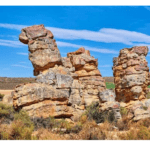The Cederberg Mountains
The Cederberg Mountains are named after the Clanwilliam cedar. Other predominant vegetation is Mediterranean fynbos in the wetter south and west, changing to semi-desert scrub in the north and east
The mountains are well known for their interesting rock formations. Some fine examples of San rock art are in caves and overhangs throughout the area such as the Stadsaal Cave. The mountains cover 50 km North/South and 20 km East /West. To the North are the Pakhuis Mountains and in the South are the KoueBokkeveld Mountains and the Skurweberge.
The highest peaks are Sneeuberg (2026 m) and Tafelberg (1969 m). Well-known landmarks include the Maltese Cross, Wolfberg Arch, and Wolfberg Cracks. The Cederberg is renowned for its quality of rock climbing routes, particularly around the Krakadouw and Tafelberg peaks. These rock formations are Table Mountain Sandstone and tend to be reddish in colour. Within the formations are bands of shale and several important fossils have been found here. These fossils include those of primitive fish which have been dated to 450 million years ago.
Boer War Connection
.The Cederberg mountains were most likely the southernmost battleground of the Second Boer War. A small band of Boer guerrillas came here from the Boer republics in the north in the hope of gaining popular support amongst the local farmers. The farmers may have had no sympathy for the British but they knew who was going to win the war.
Boer commandos were confronted in the Cederberg by a single Englishman, who ordered them to surrender. They laughed at him because he was alone and there were several of them. They attempted to reason with him but he would not back down. The place where he fell is called Engelsmanskloof.
Hikes in the Cederberg
Stargazing
Summer here is hot and dry with clear skies, which are ideal for stargazing, and is home to an amateur


